General
Revamp Your Space: Full Home Renovation Services
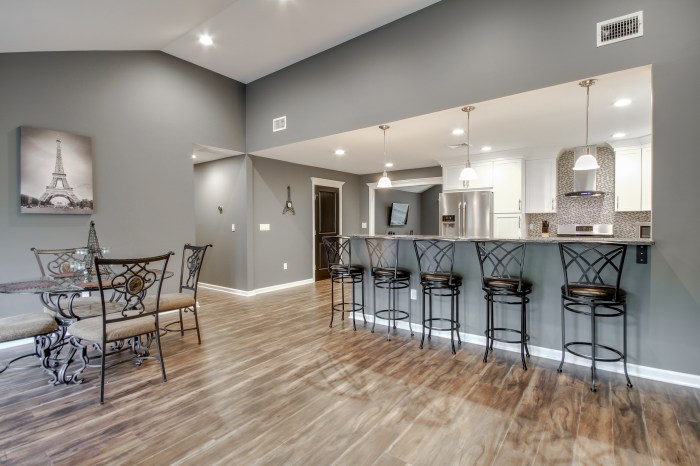
Embark on a journey to transform your living space with our comprehensive full home renovation services. From initial planning to selecting the perfect finishes, we've got you covered every step of the way. Get ready to elevate your home to new heights of style and functionality.
Overview of Full Home Renovation Services
Full home renovation services encompass a comprehensive approach to upgrading and transforming all aspects of a residential property. This includes renovating multiple rooms, changing layouts, upgrading utilities, and enhancing the overall aesthetic appeal of the home.
Opting for a full home renovation service offers several benefits over individual upgrades. Firstly, it allows for a cohesive and unified design throughout the entire house, ensuring that all elements complement each other seamlessly. Additionally, a full renovation can increase the overall value of the property significantly, making it a worthwhile investment for homeowners.
Typical Process Involved in a Full Home Renovation Service
When undertaking a full home renovation, the process usually begins with an initial consultation with the renovation team to discuss the homeowner's vision, budget, and timeline. Following this, a detailed plan is created, outlining the scope of work, materials needed, and estimated costs.
- Demolition and Preparation: The existing structures and finishes are removed, and the space is prepared for the renovation work.
- Structural Work: Any necessary structural changes or repairs are carried out to ensure the integrity and safety of the home.
- Plumbing, Electrical, and HVAC Upgrades: Utilities such as plumbing, electrical, and heating/cooling systems are upgraded to meet current standards and improve efficiency.
- Interior Finishes: This involves installing new flooring, cabinetry, countertops, fixtures, and other interior elements to enhance the functionality and aesthetics of the space.
- Exterior Upgrades: Exterior renovations may include landscaping, siding replacement, roof repairs, and other enhancements to improve curb appeal.
Planning Stage
When embarking on a full home renovation project, the planning stage is crucial to ensure a smooth and successful transformation of your space. This phase involves laying down the groundwork and making key decisions that will shape the entire renovation process.
Initial Steps in Planning a Full Home Renovation
Before diving into the renovation work, there are several important steps to take during the planning stage:
- Assess the current condition of your home and identify areas that require renovation.
- Set clear goals and priorities for the renovation project.
- Research and gather inspiration from design magazines, websites, and social media platforms.
- Create a timeline for the renovation process, taking into account any deadlines or events.
Setting a Budget for a Full Home Renovation Project
Setting a realistic budget is essential to ensure that your renovation project stays on track financially. Here are some key steps to follow:
- Conduct research to understand the average costs of renovation materials and labor in your area.
- Factor in a contingency fund for unexpected expenses that may arise during the renovation.
- Determine your priorities and allocate the budget accordingly to areas that matter most to you.
- Consult with a financial advisor or contractor to get a better understanding of the costs involved.
Importance of Creating a Comprehensive Design Plan
Before starting any renovations, it is crucial to have a detailed design plan in place. This will help streamline the renovation process and avoid costly mistakes. Here's why creating a comprehensive design plan is important:
- Allows you to visualize the end result and make informed decisions about the layout, materials, and finishes.
- Helps you communicate your vision clearly to contractors and designers involved in the project.
- Ensures that all aspects of the renovation are considered, from structural changes to interior design elements.
- Provides a roadmap for the renovation process, keeping the project on track and within budget.
Choosing the Right Contractor
When embarking on a full home renovation project, one of the most crucial decisions you'll make is choosing the right contractor. A reputable and skilled contractor can make all the difference in the success of your renovation.
Types of Contractors for Renovation Projects
There are different types of contractors you can consider for your renovation project:
- General Contractors:These contractors oversee the entire renovation project, managing subcontractors and coordinating all aspects of the work.
- Design-Build Firms:These firms handle both the design and construction phases of the project, offering a streamlined approach.
- Specialty Contractors:These contractors specialize in specific aspects of the renovation, such as plumbing, electrical work, or flooring.
Research and Selection Tips
Before hiring a contractor, it's essential to do thorough research and consider the following tips:
- Check for proper licensing and insurance to ensure the contractor is qualified and covered in case of accidents.
- Ask for references and portfolios to review past projects and gauge the quality of work.
- Get multiple quotes to compare pricing and services offered by different contractors.
- Communicate your expectations clearly and ensure the contractor understands your vision for the renovation.
Types of Renovations Offered
When it comes to full home renovations, there are several common areas that are typically included in the process. These areas often encompass spaces that are heavily used and can benefit the most from a refresh or upgrade.
Kitchen Renovations
Kitchen renovations are popular as they can significantly increase the functionality and aesthetic appeal of the heart of the home. This may involve updating cabinets, countertops, appliances, and lighting to create a more modern and efficient space for cooking and entertaining.
Bathroom Renovations
Bathroom renovations are another common part of a full home renovation. Upgrading fixtures, tiling, showers, and vanities can enhance the comfort and style of these spaces, making them more enjoyable and functional for everyday use.
Basement Renovations
Basement renovations offer the opportunity to expand living space and add value to the home. This may involve finishing the basement to create a cozy living area, home office, or entertainment space, complete with proper insulation and lighting.
Exterior Renovations
Exterior renovations focus on enhancing the curb appeal and overall appearance of the home
How to Prioritize Renovations
When deciding on which renovations to prioritize, it's essential to consider your needs, budget, and timeline. Start by addressing any structural or safety concerns first, then move on to projects that will have the most significant impact on your daily life and overall home value.
Prioritizing renovations based on what is essential and feasible within your budget and timeframe will help you achieve a successful full home renovation.
Materials and Finishes
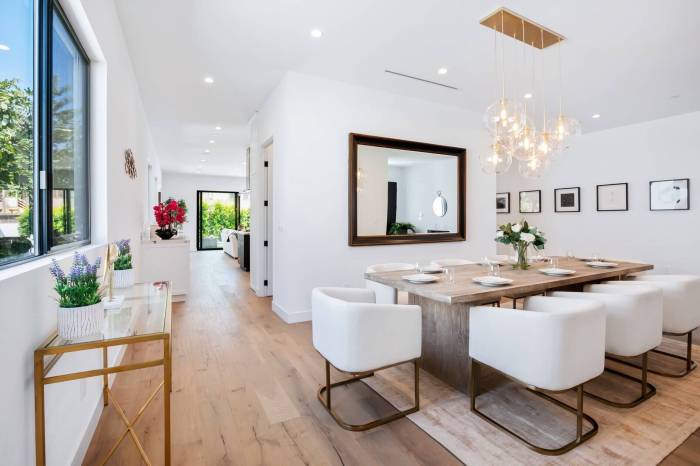
When it comes to a full home renovation, selecting high-quality materials is crucial for achieving a durable and aesthetically pleasing result. The materials used can significantly impact the overall look, feel, and longevity of the renovation project. Additionally, choosing finishes that complement the design aesthetic of your home can elevate the entire space, creating a cohesive and polished look.
Finding the right balance between cost and quality is essential to ensure that you get the best value for your investment.
Selecting High-Quality Materials
Choosing high-quality materials for your full home renovation is essential for durability and long-term satisfaction. Here are some key points to consider:
- Opt for reputable brands and suppliers to ensure the materials meet quality standards.
- Consider the specific requirements of each area in your home, such as moisture resistance for bathrooms or durability for high-traffic areas.
- Invest in materials that are not only visually appealing but also sustainable and eco-friendly for a more responsible renovation.
Choosing Complementary Finishes
Selecting finishes that complement the overall design aesthetic of your home is crucial for achieving a cohesive look. Here are some tips to guide your decision-making:
- Consider the existing style of your home and choose finishes that enhance and elevate that style.
- Coordinate finishes across different rooms to create a harmonious flow throughout your home.
- Experiment with textures, colors, and patterns to add visual interest and personality to your space.
Balancing Cost and Quality
When selecting materials and finishes for your full home renovation, it's important to find a balance between cost and quality. Here's how you can make informed decisions:
- Set a realistic budget for your renovation project and prioritize areas where quality is most crucial.
- Research different material options and compare prices to find the best value for your investment.
- Consult with your contractor or designer to explore cost-effective alternatives without compromising on quality.
Project Management
Effective project management is crucial in ensuring a successful full home renovation. The project manager plays a key role in overseeing the entire process, coordinating tasks, managing timelines, and ensuring quality standards are met.
Role of a Project Manager
- Coordinates with the renovation team, subcontractors, and suppliers.
- Creates and maintains a detailed project schedule.
- Manages the budget and procurement of materials.
- Addresses any issues or changes that may arise during the renovation.
Effective Communication
- Establish clear communication channels with the project manager from the beginning.
- Regularly update the project manager on any concerns, changes, or preferences.
- Ask questions and seek clarification whenever needed to avoid misunderstandings.
- Utilize project management tools or software for better communication and collaboration.
Tips for Staying Organized and on Schedule
- Create a renovation timeline with key milestones and deadlines.
- Maintain a renovation binder or digital folder with all important documents, contracts, and permits.
- Regularly review progress with the project manager and address any delays promptly.
- Stay flexible and be prepared to adjust plans if unexpected issues arise.
Summary

As we conclude our discussion on full home renovation services, remember that a well-planned renovation can truly make a house feel like a dream home. With the right team and a clear vision, your renovation project is sure to exceed expectations.
Start envisioning the possibilities today.
Query Resolution
What does full home renovation services encompass?
Full home renovation services cover a complete overhaul of your property, including structural changes, interior design upgrades, and more.
How do I set a budget for a full home renovation project?
Setting a budget involves assessing your financial situation, prioritizing needs, and getting quotes from contractors to understand costs.
How can I choose the right contractor for full home renovation services?
Researching, checking references, and comparing different types of contractors are essential steps in selecting the right team for your project.
What are common areas in a home that are typically part of a full renovation?
Common areas include kitchens, bathrooms, basements, and exteriors, but the scope can vary based on individual needs.
How important is it to select high-quality materials for a full home renovation?
High-quality materials ensure durability and a polished finish, enhancing the overall look and feel of your renovated space.
General
Captivating Fire Pit Patio Design Ideas to Transform Your Outdoor Space
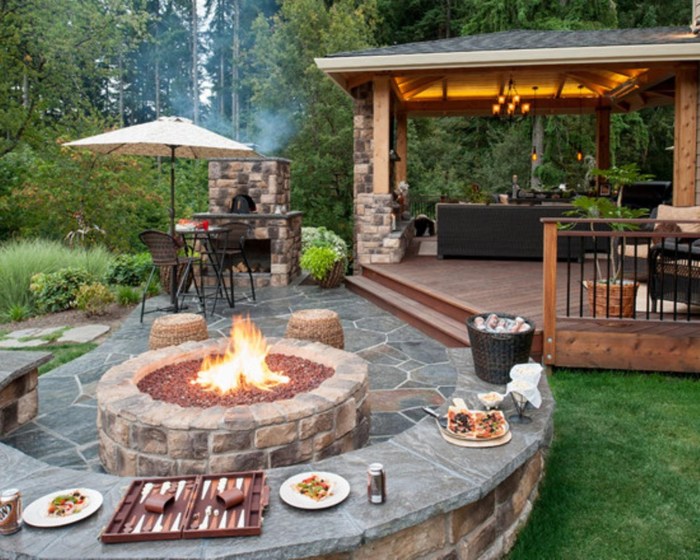
Exploring the realm of fire pit patio design ideas opens up a world of creativity and tranquility for your outdoor sanctuary. From cozy gatherings to starlit nights, the allure of a well-designed fire pit patio is undeniable. Let's embark on a journey to discover the key elements that can elevate your outdoor space to new heights.
As we delve deeper into the nuances of fire pit patio design, we uncover the art of blending functionality with aesthetics to create a harmonious outdoor oasis.
Introduction to Fire Pit Patio Design Ideas
Fire pit patio design involves creating outdoor spaces that incorporate a fire pit as a focal point. It combines functionality and aesthetics to enhance the ambiance of the outdoor area.
Designing a fire pit patio is essential for outdoor spaces as it provides a cozy gathering spot for family and friends. It can extend the usability of the outdoor area beyond daylight hours and create a welcoming atmosphere for socializing or relaxation.
Importance of Fire Pit Patio Design
- Enhances outdoor living experience: A well-designed fire pit patio can transform an ordinary outdoor space into a cozy retreat that can be enjoyed year-round.
- Adds a focal point: A fire pit serves as a central element that draws people together and creates a warm and inviting atmosphere.
- Increases property value: A thoughtfully designed fire pit patio can enhance the overall appeal and value of a property, making it more attractive to potential buyers.
Benefits of Incorporating a Fire Pit into Patio Design
- Provides warmth and comfort: A fire pit can extend the usability of the outdoor space during cooler evenings or seasons, providing warmth and creating a cozy ambiance.
- Encourages social gatherings: The presence of a fire pit encourages gatherings and facilitates conversations, making it a popular spot for hosting friends and family.
- Adds aesthetic appeal: A well-designed fire pit can enhance the visual appeal of the patio, creating a focal point that complements the overall design of the outdoor space.
Types of Fire Pits for Patio Design
When it comes to choosing a fire pit for your patio design, there are several options to consider. Each type of fire pit has its own set of features and benefits, so it's essential to understand the differences before making a decision.
Wood-Burning Fire Pits
Wood-burning fire pits are a classic choice for patio designs. They provide a traditional campfire experience and create a cozy ambiance. However, they require regular maintenance, as you need to constantly add wood and clean up ashes. These fire pits are also the most affordable option and can be easily customized with different types of wood for varying scents and crackling sounds.
Gas Fire Pits
Gas fire pits are a convenient and low-maintenance option for patio designs. They are easy to ignite with a flip of a switch and can be controlled with precision, allowing you to adjust the flame height and temperature. Gas fire pits are also smoke-free, making them a cleaner option for outdoor gatherings.
However, they tend to be more expensive upfront due to installation costs and require a gas line connection.
Propane Fire Pits
Propane fire pits offer the flexibility of being portable and easy to set up in different areas of your patio. They run on propane tanks, which can be easily replaced when empty. Propane fire pits are also clean-burning and produce minimal smoke, making them a suitable option for those with allergies or respiratory issues.
However, the ongoing cost of propane refills should be considered when choosing this type of fire pit.Considerations for Choosing a Fire Pit:
Size and Space
Determine the available space on your patio and choose a fire pit that fits comfortably without overcrowding the area.
Fuel Source
Consider the convenience, cost, and maintenance requirements of different fuel sources (wood, gas, propane) before making a decision.
Safety Features
Look for fire pits with safety features like spark screens, flame controls, and sturdy construction to ensure a safe outdoor experience.
Design and Style
Select a fire pit that complements your patio design and enhances the overall aesthetic appeal of your outdoor space.
Patio Layout and Design Elements
When it comes to designing a patio with a fire pit, there are several key elements to consider to create a cozy and inviting outdoor space. From the layout and seating arrangement to the choice of materials and lighting, every detail plays a crucial role in enhancing the overall aesthetics of your fire pit patio.
Seating Arrangement and Focal Point
One of the most important aspects of patio design is the seating arrangement around the fire pit. Consider placing comfortable outdoor furniture such as sofas, chairs, or benches in a circular or semi-circle formation to encourage conversation and interaction
Design Elements for Aesthetics
- Materials: Choose materials that complement the overall style of your home and outdoor space. Options like stone, brick, or concrete are popular choices for fire pit patios due to their durability and timeless appeal.
- Colors: Incorporate colors that harmonize with the natural surroundings and create a cohesive look. Earthy tones like browns, greens, and neutrals can help to create a warm and inviting atmosphere.
- Lighting: Enhance the ambiance of your fire pit patio with strategic lighting. Consider incorporating overhead string lights, lanterns, or built-in LED lights to illuminate the space and create a cozy glow.
Creative Integration Ideas
To seamlessly integrate the fire pit into your patio design, consider the following creative ideas:
- Build a seating wall around the fire pit to provide additional seating and create a cozy nook for relaxation.
- Add a fire pit table that doubles as a dining area or a place to set drinks and snacks while enjoying the warmth of the fire.
- Incorporate natural elements like plants, flowers, or water features to soften the hardscape and add a touch of greenery to the space.
Fire Pit Patio Safety Measures
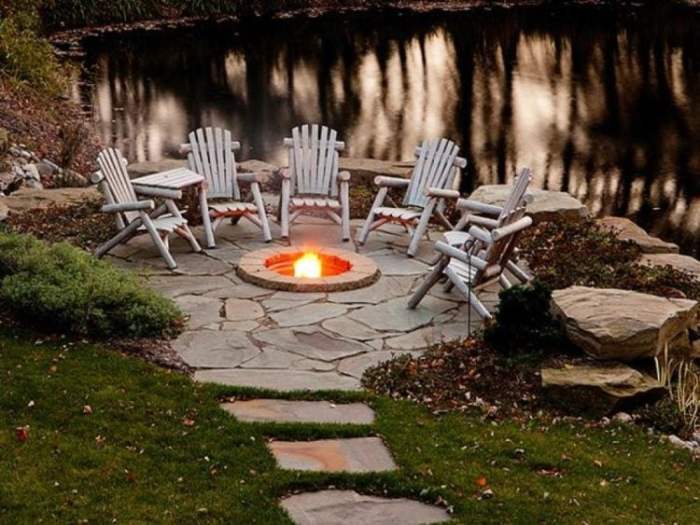
When designing a fire pit patio, it is crucial to prioritize safety to prevent accidents and ensure a comfortable outdoor space for you and your guests. This includes taking necessary precautions and following guidelines to create a secure environment.
Fire Pit Placement and Clearance Requirements
When determining the placement of your fire pit on the patio, make sure to consider the following clearance requirements:
- Ensure the fire pit is placed at least 10 feet away from any structures, including your home, trees, or fences, to prevent the risk of fire spreading.
- Check for overhead clearance and make sure there are no low-hanging branches or structures that could potentially catch fire.
- Keep the fire pit away from high-traffic areas to avoid accidents, especially if children or pets are present.
- Consider wind direction and avoid placing the fire pit in a windy area to prevent embers from spreading.
Selecting Fire-Resistant Materials
When choosing materials for your patio surface and surroundings, opt for fire-resistant options to reduce the risk of fire hazards:
- Use materials like concrete, brick, or stone for the patio surface as they are less likely to catch fire compared to wood or composite materials.
- Avoid placing flammable items near the fire pit, such as furniture cushions, curtains, or decorations that could easily ignite.
- Consider incorporating a non-combustible border around the fire pit to create a safe barrier and prevent accidental contact with the flames.
- Regularly inspect and maintain the fire pit and surrounding materials to ensure they remain in good condition and pose no fire risks.
Last Word

In conclusion, fire pit patio design ideas offer a myriad of possibilities to enhance your outdoor living experience. From selecting the right fire pit type to incorporating safety measures, the journey to creating your dream patio is filled with endless inspiration.
Embrace the warmth and charm of a well-designed fire pit patio, and let your outdoor space become a true reflection of your style and personality.
Common Queries
What are some key considerations when selecting a fire pit for a patio?
When choosing a fire pit for your patio, consider factors such as size, fuel type, and design style to ensure it complements your outdoor space seamlessly.
How can lighting be used to enhance the ambiance of a fire pit patio?
Strategic placement of lighting fixtures, such as string lights or lanterns, can create a warm and inviting atmosphere around the fire pit, perfect for cozy gatherings.
Are there any safety tips to keep in mind when designing a fire pit patio?
It's essential to maintain proper clearance around the fire pit, use fire-resistant materials, and have a fire extinguisher nearby to ensure a safe and enjoyable outdoor experience.
General
Exploring the Beauty of Hardie Cobblestone
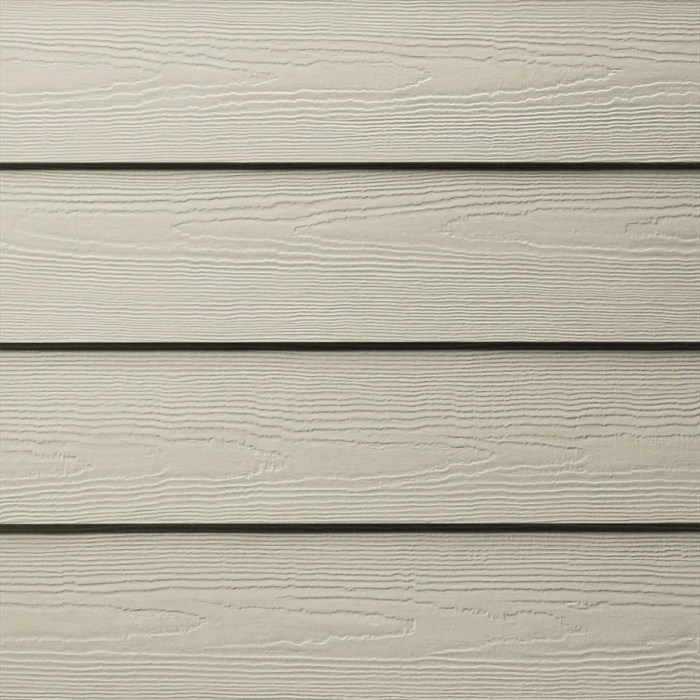
Step into the world of Hardie Cobblestone, a versatile and durable material that has been revolutionizing landscapes and outdoor spaces. From its composition to applications, this paragraph sets the stage for a fascinating journey into the realm of Hardie Cobblestone.
Delve deeper into the installation process, design options, and durability features that make Hardie Cobblestone a top choice for various projects.
Introduction to Hardie Cobblestone
Hardie Cobblestone is a durable and versatile building material made from a composite of cement, sand, and cellulose fibers. It is designed to mimic the look of traditional cobblestone while providing the strength and longevity of modern construction materials.
Characteristics and Benefits
- Resilient to harsh weather conditions, including extreme heat, cold, and moisture.
- Low maintenance requirements, reducing the need for frequent repairs or replacements.
- Fire-resistant properties, providing added safety and peace of mind.
- Enhanced durability, ensuring a long-lasting finish that retains its appearance over time.
Hardie Cobblestone offers a range of benefits due to its composition and design:
Applications
- Exterior facades of residential homes and commercial buildings.
- Walkways, driveways, and pathways to create a classic cobblestone look.
- Landscape designs, including garden borders and edging for a timeless finish.
Hardie Cobblestone is commonly used in various construction projects for its versatility and aesthetic appeal:
Installation and Maintenance
When it comes to installing and maintaining Hardie Cobblestone, there are key steps and practices to follow to ensure longevity and durability.
Installation of Hardie Cobblestone
- Prepare the area: Clear the surface where the cobblestone will be installed, ensuring it is clean and level.
- Apply the base: Lay down a compacted base material, such as gravel or sand, to provide a stable foundation.
- Place the cobblestone: Arrange the Hardie Cobblestone units in the desired pattern, making sure they fit tightly together.
- Secure the cobblestone: Use a mallet to ensure the cobblestones are firmly in place and level with each other.
- Fill the joints: Once all cobblestones are in place, fill the joints with sand to secure the units and prevent shifting.
Recommended Maintenance Practices
- Regular cleaning: Sweep or hose down the cobblestone surface to remove dirt, debris, and stains.
- Weed control: Keep the joints between cobblestones free from weeds by applying weed killer or manually removing them.
- Sealing: Consider sealing the cobblestone surface to protect it from water damage and prolong its lifespan.
- Inspect for damage: Periodically check for any cracks or loose cobblestones that may need to be repaired or replaced.
Comparison with Traditional Cobblestone Installation
Installing Hardie Cobblestone offers advantages over traditional cobblestone, as it is typically lighter in weight, easier to handle, and more uniform in size and shape. Traditional cobblestone, on the other hand, requires more labor-intensive installation, as each stone is unique and may need to be cut to fit properly.
Additionally, Hardie Cobblestone provides a more consistent and level surface compared to traditional cobblestone, which can vary in height and create uneven pathways.
Design and Customization
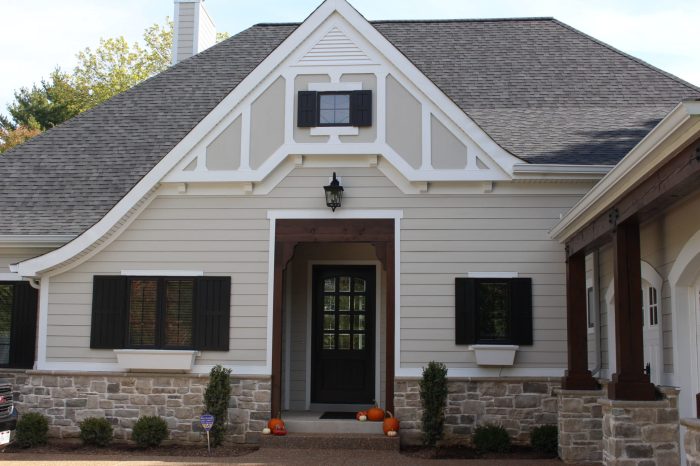
When it comes to Hardie Cobblestone, the design options are endless, allowing you to create a unique and customized look for your project
Color Variations
Hardie Cobblestone offers a wide range of color variations to choose from, including earth tones, greys, and even bolder colors. This allows you to match the cobblestone to the overall color scheme of your project, enhancing its visual appeal.
Patterns
In addition to color variations, Hardie Cobblestone also offers different patterns to suit your design preferences. Whether you prefer a random pattern for a more natural look or a more structured layout for a contemporary feel, you can easily customize the cobblestone to fit your vision.
Tips for Customization
- Mix and match different colors and patterns to create a unique look.
- Consider incorporating borders or accents to add visual interest.
- Experiment with different layouts to find the perfect design for your project.
Durability and Longevity

When it comes to durability, Hardie Cobblestone is a top choice for outdoor paving projects. Made from fiber cement, this material is resistant to harsh weather conditions, including extreme heat, cold, and moisture. Its robust composition ensures that it can withstand heavy foot traffic and the weight of vehicles without cracking or breaking easily.Compared to natural stone, Hardie Cobblestone offers superior longevity.
Natural stone is prone to erosion, fading, and cracking over time, especially when exposed to the elements. In contrast, Hardie Cobblestone maintains its color, shape, and texture for many years, making it a cost-effective and low-maintenance option for outdoor spaces.
Projects Showcasing Long-Term Durability
- One notable project featuring the long-term durability of Hardie Cobblestone is a driveway installation in a high-traffic area. Despite daily use by multiple vehicles, the Hardie Cobblestone driveway remains intact and visually appealing, showcasing its resilience.
- In another project, a patio paved with Hardie Cobblestone has stood the test of time, maintaining its structural integrity and aesthetic appeal even after years of exposure to sunlight, rain, and snow.
- A commercial courtyard paved with Hardie Cobblestone has proven to be a durable and long-lasting choice, with minimal maintenance required to keep it looking pristine year after year.
Ending Remarks
As we conclude our exploration of Hardie Cobblestone, it's evident that this material offers a perfect blend of aesthetics and functionality. With its longevity and customizability, Hardie Cobblestone continues to stand out as a premium choice for landscaping and construction needs.
Clarifying Questions
Is Hardie Cobblestone suitable for DIY projects?
Yes, Hardie Cobblestone is relatively easy to install and can be a great option for DIY enthusiasts looking to enhance their outdoor spaces.
Can Hardie Cobblestone withstand harsh weather conditions?
Absolutely, Hardie Cobblestone is known for its durability and can withstand various weather elements without losing its appeal.
Are there different shapes and sizes available for Hardie Cobblestone?
Yes, Hardie Cobblestone comes in a variety of shapes and sizes, allowing for creative customization in different projects.
How does Hardie Cobblestone compare to natural stone in terms of maintenance?
Hardie Cobblestone requires minimal maintenance compared to natural stone, making it a convenient choice for long-term use.
Can Hardie Cobblestone be used for both residential and commercial projects?
Absolutely, Hardie Cobblestone is versatile enough to be used in various settings, from residential gardens to commercial landscaping projects.
General
Exploring Gutter Installation Cost Per Foot: Factors, Materials, and Process
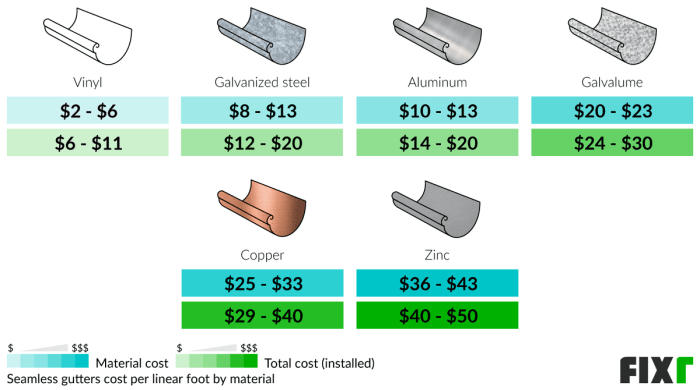
Diving into the world of gutter installation costs per foot, this introduction aims to provide a comprehensive overview of the key elements that influence pricing, material options, and the installation process. From cost factors to material choices, readers will gain valuable insights into this essential home improvement aspect.
As we delve deeper, we'll uncover the nuances of gutter installation costs per foot, shedding light on commonly overlooked details that can impact the overall expense of this crucial home upgrade.
Cost Factors
When it comes to determining the cost of gutter installation per foot, several factors come into play. These factors can significantly influence the overall cost and should be taken into consideration before starting the installation process.
Material Quality Impact
The quality of materials used for gutter installation plays a crucial role in determining the cost per foot. Higher quality materials such as aluminum or copper gutters are more expensive upfront but tend to be more durable and require less maintenance over time.
On the other hand, vinyl or galvanized steel gutters may be more affordable initially but might need to be replaced sooner, leading to higher long-term costs.
Size and Type of Gutters
The size and type of gutters selected for installation also impact the overall cost per foot. Larger gutters or specialized types such as seamless gutters may cost more due to the additional materials and labor required for installation. It is essential to choose the appropriate size and type of gutters based on your specific needs and budget.
Role of Labor Expenses
Labor expenses are another significant factor in determining the cost of gutter installation per foot. The complexity of the installation, the experience of the laborers, and the location of the property can all influence labor costs. Additionally, factors such as removing old gutters, repairing fascia boards, or installing gutter guards can add to the overall labor expenses.
It is essential to factor in labor costs when budgeting for gutter installation to ensure a smooth and successful project.
Material Options

When it comes to gutter installation, there are several material options to choose from. Each material has its own cost per foot, durability, and maintenance requirements. Let's explore the most common materials used for gutters.
Aluminum Gutters
Aluminum gutters are a popular choice due to their affordability and lightweight nature. The cost per foot of aluminum gutters typically ranges from $4 to $10. They are relatively easy to install and require minimal maintenance. However, aluminum gutters may not be as durable as other materials and can be prone to dents and damage.
Vinyl Gutters
Vinyl gutters are the most budget-friendly option, with a cost per foot ranging from $3 to $6. They are lightweight, easy to install, and resistant to rust and corrosion. However, vinyl gutters may not be as durable as other materials and can crack or break in extreme weather conditions.
Steel Gutters
Steel gutters are a more durable option, with a cost per foot ranging from $8 to $20. They are sturdy and can withstand harsh weather conditions. However, steel gutters are prone to rust and corrosion over time, requiring regular maintenance to prevent deterioration.
Copper Gutters
Copper gutters are a high-end option known for their durability and elegant appearance. The cost per foot of copper gutters is the highest, ranging from $15 to $30. Copper gutters are resistant to rust and corrosion, developing a beautiful patina over time.
However, they require specialized installation and maintenance to preserve their aesthetics.Choosing the right material for your gutter installation can impact the overall cost, durability, and maintenance requirements. Consider your budget, climate, and aesthetic preferences when selecting the best material for your home.
Installation Process
Installing gutters involves a step-by-step process that ensures proper functionality and longevity. Before the installation begins, there are some preparatory steps to consider, such as measuring and planning the slope and placement of the gutters. The slope and placement can affect the overall cost of the installation, as they determine how efficiently water will flow through the system
Proper drainage is crucial in gutter installation to prevent water damage to the property.
Step-by-Step Installation Process
- Measure and plan the slope: Ensure that the gutters are sloped correctly to allow water to flow towards the downspouts.
- Prepare the area: Clear any debris or obstacles that may obstruct the installation process.
- Install hangers: Secure the gutter hangers to the fascia board to support the weight of the gutters.
- Attach the gutters: Connect the gutter sections and secure them in place using screws or rivets.
- Install downspouts: Attach the downspouts to the gutters to direct water away from the foundation.
- Test the system: Run water through the gutters to ensure proper drainage and identify any leaks or issues.
Importance of Proper Drainage
Proper drainage in gutter installation is essential to prevent water buildup and potential damage to the property. Without proper drainage, water can seep into the foundation, causing cracks and structural issues. Additionally, stagnant water in the gutters can lead to mold growth and attract pests.
Ensuring that the gutters are sloped correctly and free of debris is crucial for maintaining the integrity of the system and protecting the property from water damage.
Additional Costs
When considering gutter installation costs per foot, it's important to account for potential additional expenses that may arise. These extra costs can impact the overall budget and should be factored into your decision-making process.
Gutter Guards or Screens
Adding gutter guards or screens to your gutter system can provide added protection against debris buildup and clogging. While this can help prevent costly maintenance issues in the future, it does come with an additional cost. The price of gutter guards or screens can vary depending on the material and quality, so be sure to factor this into your budget when planning your gutter installation project.
Downspouts, Corners, and Hangers
The number of downspouts, corners, and hangers needed for your gutter system can also impact the overall cost of installation. These components are essential for proper functionality and durability of your gutters. The more downspouts, corners, and hangers required, the higher the installation cost will be.
It's important to work with a professional installer to determine the optimal placement and quantity of these components for your specific property.
Maintenance and Repair Costs
While the initial cost of gutter installation is a one-time expense, it's important to consider potential maintenance and repair costs in the future. Over time, gutters may require cleaning, repairs, or even replacement due to wear and tear or damage.
Regular maintenance can help prolong the lifespan of your gutters and prevent costly repairs down the line. Be prepared to budget for these ongoing maintenance and repair expenses to ensure the longevity and effectiveness of your gutter system.
Final Conclusion
In conclusion, understanding the various factors that contribute to gutter installation costs per foot is key to making informed decisions for your home. By grasping the significance of materials, labor, and additional expenses, you'll be better equipped to navigate the complexities of gutter installation pricing.
Dive into this insightful discussion to enhance your knowledge and make savvy choices for your property.
Answers to Common Questions
What factors influence the cost of gutter installation per foot?
Factors such as material quality, gutter size, type, and labor expenses can all impact the cost per foot of gutter installation.
What are the common materials used for gutter installation?
Common materials for gutters include aluminum, vinyl, steel, and copper, each with varying costs per foot and maintenance requirements.
How does the installation process of gutters typically unfold?
The installation process involves steps like preparatory work, considering gutter slope and placement, and ensuring proper drainage for effective gutter functionality.
Are there additional costs to consider besides basic installation per foot?
Additional costs may arise from installing gutter guards, downspouts, corners, hangers, and potential maintenance or repair expenses over time.
-

 General2 months ago
General2 months agoSmart Lifestyle Design Tips for Small Urban Homes: Transforming Limited Spaces into Functional Living Areas
-
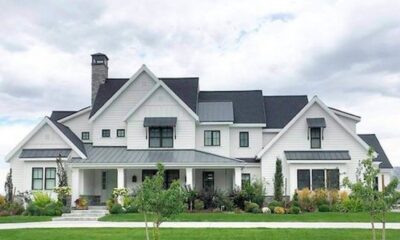
 General2 months ago
General2 months agoModern Farmhouse Exterior Ideas for Luxury Lifestyle Homes: A Guide to Elevated Living
-
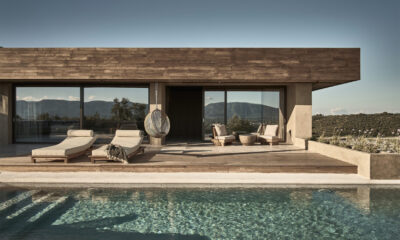
 General2 months ago
General2 months agoCaptivating Title: Interior and Exterior Design Ideas for Wellness Retreats
-

 General2 months ago
General2 months agoAI-powered lifestyle design tools for home planning: Revolutionizing Efficiency and Customization
-

 General2 months ago
General2 months agoLuxury Outdoor Living Spaces for Healthy Lifestyles: Elevate Your Outdoor Experience
-

 Business Tools2 months ago
Business Tools2 months agoThe Best CRM Systems for Lifestyle Coaches and Consultants
-
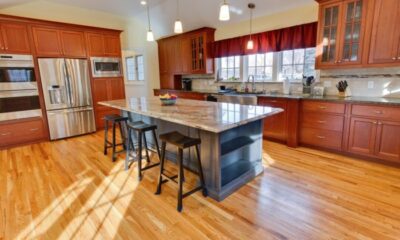
 General3 weeks ago
General3 weeks agoRevamping Your Space: Kitchen Remodeling Near Me
-
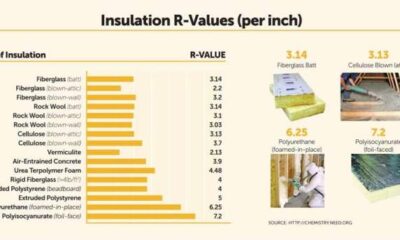
 General3 weeks ago
General3 weeks agoRoof Insulation Materials Comparison: A Comprehensive Guide





